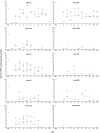Extraintestinal spread and replication of a homologous EC rotavirus strain and a heterologous rhesus rotavirus in BALB/c mice
- PMID: 16699002
- PMCID: PMC1472171
- DOI: 10.1128/JVI.02664-05
Extraintestinal spread and replication of a homologous EC rotavirus strain and a heterologous rhesus rotavirus in BALB/c mice
Abstract
Although rotavirus infection has generally been felt to be restricted to the gastrointestinal tract, over the last two decades there have been sporadic reports of children with acute or fatal cases of rotavirus gastroenteritis testing positive for rotavirus antigen and/or nucleic acid in various extraintestinal locations such as serum, liver, kidney, bladder, testes, nasal secretions, cerebrospinal fluid, and the central nervous system. Recently, studies in animals and people have demonstrated that rotavirus antigenemia is a common event during natural infection. In this study, we extend these observations and compare the intestinal and extraintestinal spread of wild-type homologous murine rotavirus EC and a heterologous strain, rhesus rotavirus (RRV), in newborn mice. A strand-specific quantitative reverse transcription-PCR (ssQRT-PCR) assay was used to quantify the ability of different rotavirus strains to spread and replicate extraintestinally. Both strain EC and RRV were detected extraintestinally in the mesenteric lymph nodes (MLN), livers, lungs, blood, and kidneys. Extraintestinal replication, as measured by ssQRT-PCR, was most prominent in the MLN and occurred to a lesser degree in the livers, kidneys, and lungs. In the MLN, strain EC and RRV had similar (P < 0.05) RNA copy numbers, although EC was present at a 10,000-fold excess over RRV in the small intestine. Rotavirus nonstructural protein 4 (NSP4) and/or assembled triple-layered particles, indicated by immunostaining with the VP7 conformation-dependent monoclonal antibody 159, were detected in the MLN, lungs, and livers of EC- and RRV-inoculated mice, confirming the ssQRT-PCR findings. Infectious RRV was detected in the MLN in quantities exceeding the amount present in the small intestines or blood. The cells in the MLN that supported rotavirus replication included dendritic cells and potentially B cells and macrophages. These data indicate that extraintestinal spread and replication occurs commonly during homologous and some heterologous rotaviral infections; that the substantial host range restrictions for rhesus rotavirus, a heterologous strain present in the intestine, are not necessarily apparent at systemic sites; that the level and location of extraintestinal replication varies between strains; that replication can occur in several leukocytes subsets; and that extraintestinal replication is likely a part of the normal pathogenic sequence of homologous rotavirus infection.
Figures






Similar articles
-
Role of interferon in homologous and heterologous rotavirus infection in the intestines and extraintestinal organs of suckling mice.J Virol. 2008 Aug;82(15):7578-90. doi: 10.1128/JVI.00391-08. Epub 2008 May 21. J Virol. 2008. PMID: 18495762 Free PMC article.
-
Rotavirus viremia and extraintestinal viral infection in the neonatal rat model.J Virol. 2006 May;80(10):4820-32. doi: 10.1128/JVI.80.10.4820-4832.2006. J Virol. 2006. PMID: 16641274 Free PMC article.
-
Rotavirus acceleration of murine type 1 diabetes is associated with increased MHC class I-restricted antigen presentation by B cells and elevated proinflammatory cytokine expression by T cells.Virus Res. 2014 Jan 22;179:73-84. doi: 10.1016/j.virusres.2013.11.009. Epub 2013 Nov 15. Virus Res. 2014. PMID: 24246305
-
Extraintestinal Involvement of Rotavirus Infection in Children.Arch Iran Med. 2015 Sep;18(9):604-5. Arch Iran Med. 2015. PMID: 26317602 Review.
-
Rotavirus vaccines and vaccination in Latin America.Rev Panam Salud Publica. 2000 Nov;8(5):305-31. doi: 10.1590/s1020-49892000001000002. Rev Panam Salud Publica. 2000. PMID: 11190969 Review.
Cited by
-
Rotavirus NSP1 inhibits expression of type I interferon by antagonizing the function of interferon regulatory factors IRF3, IRF5, and IRF7.J Virol. 2007 May;81(9):4473-81. doi: 10.1128/JVI.02498-06. Epub 2007 Feb 14. J Virol. 2007. PMID: 17301153 Free PMC article.
-
Literature Review on Rotavirus: Disease and Vaccine Characteristics: An Advisory Committee Statement (ACS) National Advisory Committee on Immunization (NACI)†.Can Commun Dis Rep. 2010 Nov 30;36(ACS-14):1-31. doi: 10.14745/ccdr.v36i00a14. eCollection 2010 Nov 30. Can Commun Dis Rep. 2010. PMID: 31701942 Free PMC article. No abstract available.
-
Rotavirus differentially infects and polyclonally stimulates human B cells depending on their differentiation state and tissue of origin.J Virol. 2010 May;84(9):4543-55. doi: 10.1128/JVI.02550-09. Epub 2010 Feb 17. J Virol. 2010. PMID: 20164228 Free PMC article.
-
Rotavirus infection of infant and young adult nonobese diabetic mice involves extraintestinal spread and delays diabetes onset.J Virol. 2007 Jun;81(12):6446-58. doi: 10.1128/JVI.00205-07. Epub 2007 Apr 11. J Virol. 2007. PMID: 17428851 Free PMC article.
-
Retinoic Acid and Lymphotoxin Signaling Promote Differentiation of Human Intestinal M Cells.Gastroenterology. 2020 Jul;159(1):214-226.e1. doi: 10.1053/j.gastro.2020.03.053. Epub 2020 Apr 1. Gastroenterology. 2020. PMID: 32247021 Free PMC article.
References
-
- Blutt, S. E., C. D. Kirkwood, V. Parreno, K. L. Warfield, M. Ciarlet, M. K. Estes, K. Bok, R. F. Bishop, and M. E. Conner. 2003. Rotavirus antigenaemia and viraemia: a common event? Lancet 362:1445-1449. - PubMed
-
- Boshuizen, J. A., J. H. Reimerink, A. M. Korteland-van Male, V. J. van Ham, J. Bouma, G. J. Gerwig, M. P. Koopmans, H. A. Buller, J. Dekker, and A. W. Einerhand. 2005. Homeostasis and function of goblet cells during rotavirus infection in mice. Virology 337:210-221. - PubMed
-
- Brown, K. A., and P. A. Offit. 1998. Rotavirus-specific proteins are detected in murine macrophages in both intestinal and extraintestinal lymphoid tissues. Microb. Pathog. 24:327-331. - PubMed
-
- Burns, J. W., A. A. Krishnaney, P. T. Vo, R. V. Rouse, L. J. Anderson, and H. B. Greenberg. 1995. Analyses of homologous rotavirus infection in the mouse model. Virology 207:143-153. - PubMed
Publication types
MeSH terms
Substances
Grants and funding
LinkOut - more resources
Full Text Sources
Medical

